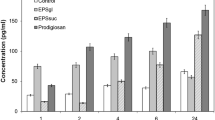Abstract
The exopolysaccharide (EPS) is a polysaccharide from cultivated Cordyceps sinensis, which possesses immunomodulatory and antitumor effects, was purified by DEAE-32 cellulose and Sephadex G-200 gel. The preliminary characters of EPS were analyzed by IR and GC, and the molecular weight was estimated by gel filtration. The effect of EPS on proliferation ability of lymphocytes from ICR mice was assayed by MTT method. The mRNA and protein expression levels of several cytokines in spleen and thymus cells were detected by RT-PCR and ELISA. The results showed that EPS consists of mannose, glucose, and galactose in a ratio of 23:1:2.6. Its molecular weight is about 1.04 × 105. EPS elevated proliferation ability of spleen lymphocytes only at 100 μg/ml after 48 h treatment. Tumor necrosis factor alpha (TNF-α), interferon-α (IFN-γ), and interleukin-2 (IL-2) mRNA levels in splenocytes and thymocytes were increased after EPS treatment for 2, 4, 8, or 20 h. EPS also significantly elevated splenic TNF-α and IFN-γ protein expressions at 100 μg/ml and increased thymic TNF-α and IFN-γ protein levels at 50 and 100 μg/ml. These data indicated that EPS may stimulate cytokine expressions of immunocytes.






Similar content being viewed by others
References
Moradali, M. F., Mostafavi, H., Ghods, S., & Hedjaroude, G. A. (2007). Immunomodulating and anticancer agents in the realm of macromycetes fungi (macrofungi). International Immunopharmacology, 7, 701–724.
Chang, Y. H., Yang, J. S., Yang, J. L., Wu, C. L., Chang, S. J., Lu, K. W., et al. (2009). Ganoderma lucidum extracts inhibited leukemia WEHI-3 cells in BALB/c mice and promoted an immune response in vivo. Bioscience, Biotechnology, and Biochemistry, 73, 2589–2594.
Hetland, G., Johnson, E., Lyberg, T., Bernardshaw, S., Tryggestad, A. M., & Grinde, B. (2008). Effects of the medicinal mushroom Agaricus blazei Murill on immunity, infection and cancer. Scandinavian Journal of Immunology, 68, 363–370.
Tzianabos, A. O. (2000). Polysaccharide immunomodulators as therapeutic agents: structural aspects and biologic function. Clinical Microbiology Reviews, 13, 523–533.
Wasser, S. P. (2002). Medicinal mushrooms as a source of antitumor and immunomodulating polysaccharides. Applied Microbiology and Biotechnology, 60, 258–274.
Liu, J. J., Huang, T. S., Hsu, M. L., Chen, C. C., & Lin, W. S. (2004). Antitumor effects of the partially purified polysaccharides from Antrodia camphorata and the mechanism of its action. Toxicology and Applied Pharmacology, 201, 186–193.
Zhao, H., Luo, Y., Lu, C., Lin, N., Xiao, C., Guan, S., et al. (2010). Enteric mucosal immune response might trigger the immunomodulation activity of Ganoderma lucidum polysaccharide in mice. Planta Medica, 76, 223–227.
Zhang, W. Y., Yang, J. Y., Chen, J. P., Hou, Y. Y., & Han, X. D. (2005). Immunomodulatory and antitumor effects of exopolysaccharide fraction (EPSF) from a cultivated Cordyceps sinense fungus on tumor-bearing mice. Biotechnology and Applied Biochemistry, 42, 9–11.
Zhang, W. Y., Li, J., Qiu, S. Q., Chen, J. P., & Zhen, Y. (2008). Effects of the exopolysaccharide fraction (EPSF) from a cultivated Cordyceps sinensis on immunocytes of H22 tumor bearing mice. Fitoterapia, 79, 168–173.
Huang, D., Zhang, W., Huang, D., & Wu, J. (2010). Antitumor activity of the aqueous extract from Sedum sarmentosum Bunge in vitro. Cancer Biotherapy & Radiopharmaceuticals, 25, 81–88.
Heinrich, P. C., Behrmann, I., Muller-Newen, G., Schaper, F., & Graeve, L. (1998). Interleukin-6-type cytokine signalling through the gp130/Jak/STAT pathway. The Biochemical Journal, 334, 297–231.
Hacker, E., Muller, K., Whiteman, D. C., Pavey, S., Hayward, N., & Walke, G. (2008). Reduced expression of IL-18 is a marker of ultraviolet radiation-induced melanomas. International Journal of Cancer, 123, 227–231.
Heikkilä, K., Ebrahim, S., & Lawlor, D. A. (2008). Systematic review of the association between circulating interleukin-6 (IL-6) and cancer. European Journal of Cancer, 44, 937–945.
Ho, M. Y., Sun, G. H., Leu, S. J., Ka, S. M., Tang, S. J., & Sun, K. H. (2008). Combination of Fasl and GM-CSF confers synergistic antitumor immunity in an in vivo model of the murine Lewis lung carcinoma. International Journal of Cancer, 123, 123–133.
Vairaktaris, E., Yapijakis, C., Serefoglou, Z., Derka, S., Vassilio, S., Nkenke, E., et al. (2008). The interleukin-10 (-1082A/G) polymorphism is strongly associated with increased risk for oral squamous cell carcinoma. Anticancer Research, 28, 309–314.
Watanabe, N., Niitsu, Y., Umeno, H., Kuriyama, H., Neda, H., Yamauchi, N., et al. (1988). Toxic effect of tumor necrosis factor on tumor vasculature in mice. Cancer Research, 48, 2179–2183.
Ikeda, H., Old, L. J., & Schreiber, R. D. (2002). The roles of IFN gamma in protection against tumor development and cancer immunoediting. Cytokine & Growth Factor Reviews, 13, 95–109.
Kim, P. K., Armstrong, M., Liu, Y., Yan, P., Bucher, B., & Zuckerbraun, B. S. (2004). IRF-1 expression induces apoptosis and inhibits tumour growth in mouse mammary cancer cells in vitro and in vivo. Oncogene, 23, 1125–1135.
Bouker, K. B., Skaar, T. C., Riggins, R. B., Harburger, D. S., Fernandez, D. R., & Zwart, A. (2005). Interferon regulatory factor-1 (IRF-1) exhibits tumour suppressor activities in breast cancer associated with caspase activation and induction of apoptosis. Carcinogenesis, 26, 1527–1535.
Connett, J. M., Badri, L., Giordano, T. J., Connett, W. C., & Doherty, G. M. (2005). Interferon regulatory factor 1 (IRF-1) and IRF-2 expression in breast cancer tissue microarrays. Journal of Interferon and Cytokine Research, 25, 587–594.
Sidky, Y. A., & Borden, E. C. (1987). Inhibition of angiogenesis by interferons: effects on tumor- and lymphocyte-induced vascular responses. Cancer Research, 47, 5155–5161.
Rosenberg, S. A. (2001). Progress in human tumour immunology and immunotherapy. Nature, 411, 380–384.
Acknowledgements
The study was supported by the National Nature Science Foundation of China (No. 30873188 to W.Y. Zhang).
Author information
Authors and Affiliations
Corresponding author
Rights and permissions
About this article
Cite this article
Sheng, L., Chen, J., Li, J. et al. An Exopolysaccharide from Cultivated Cordyceps sinensis and its Effects on Cytokine Expressions of Immunocytes. Appl Biochem Biotechnol 163, 669–678 (2011). https://doi.org/10.1007/s12010-010-9072-3
Received:
Accepted:
Published:
Issue Date:
DOI: https://doi.org/10.1007/s12010-010-9072-3




